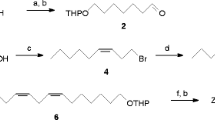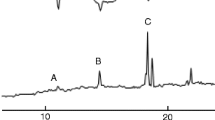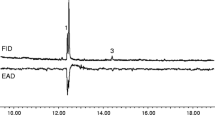Abstract
The sex pheromone glands ofPlusia chalcites release, dodecyl acetate, (Z)-7-dodecenyl acetate, (Z)-9-dodecenyl acetate, 11-dodecenyl acetate, (Z)-8-tridecenyl acetate, and (Z)-9-tetradecenyl acetate. A combination of capillary GC, GC-MS, and dimethyl disulfide derivatization enabled a rigorous identification of all these compounds, some of which were previously found in gland extracts. Bioassays in a flight tunnel showed that a ternary blend of (Z)-7-dodecenyl acetate, (Z)-9-dodecenyl acetate, and (Z)-9-tetradecenyl acetate elicited directed flights from 85 to 100% of the males tested and elicited copulation attempts, at the end of the flights, from 44 to 74% of the males tested. This blend was equal in activity to the natural gland extract. Addition of the other acetates had only a slight influence on the activity of this mixture. Substitution of either (Z)-9-dodecenyl acetate or (Z)-9-tetradecenyl acetate in this blend by 11-dodecenyl acetate gave two ternary mixtures which also elicited high levels of courtship activity, almost as high as that of the original blend. Addition of (Z)-7-dodecenyl alcohol inhibited almost totally the flight activity of males.
Similar content being viewed by others
References
Ando, T., Yoshida, S., Tatsuki, S., andTakahashi, N. 1977. Sex attractants for male Lepidoptera.Agric. Biol. Chem. 41:1485–1492.
Baker, T. C., Gaston, L. K., Mistrot Pope, M., Kuenen, L. P. S., andVetter, R. S. 1981. A high efficiency collection device for quantifying sex pheromone volatilized from female glands and synthetic sources.J. Chem. Ecol. 7:961–968.
Benn, M. H., Galbreath, R. A., Holt, V. A., Young, H., Down, G., andPriesner, E. 1982. The sex pheromone of the silver Y moth,Chrysodeixis eriosoma (Doubleday), New Zealand.Z. Naturforsch. 37c:1130–1135.
Berger, R. S. 1966. Isolation, identification, and synthesis of the sex attractant of the cabbage looper,Trichoplusia ni.Ann. Entomol. Soc. Am. 59:767–771.
Bjostad, L. B., andRoelofs, W. L. 1983. Sex pheromone biosynthesis inTrichoplusia ni: Key steps involve delta-11 desaturation and chain shortening.Science 220:1387–1389.
Bjostad, L. B., Gaston, L. K., Noble, L. L., Moyer, J. H., andShorey, H. H. 1980. Dodecyl acetate, a second pheromone component of the cabbage looper,Trichoplusia ni.J. Chem. Ecol. 6:727–734.
Bjostad, L. B., Linn, C. E., Du, J. W., andRoelofs, W. L. 1984. Identification of new sex pheromone components inTrichoplusia ni predicted from biosynthetic precursors.J. Chem. Ecol. 10:1309–1323.
Bjostad, L. B., Linn, C. E., Roelofs, W. L., andDu, J. W. 1985. Identification of new sex pheromone components inTrichoplusia ni andArgyrotaenia velutinana, predicted from biosynthetic precursors, pp. 223–237,in T.E. Acree and D.M. Soderlund (eds.). Semiochemistry Flavors and Pheromones. Walter de Gruyter, New York.
Buser, H. R., Arn, H., Guerin, P., andRauscher, S. 1983. Determination of double bond position in monounsaturated acetates by mass spectrometry of dimethyl disulfide adducts.Anal. Chem. 55:818–822.
David, H., Nesbitt, B. F., Easwaramoorthy, S., andNandagopal, V. 1985. Application of sex pheromones in sugarcane pest management.Proc. Indian Acad. Sci. 94:333–339.
Dunkelblum, E., andGothilf, S. 1983. Sex pheromone components of the Gamma moth,Autographa gamma (L.) (Lepidoptera: Noctuidae).Z. Naturforsch. 38c:1011–1014.
Dunkelblum, E., Gothilf, S., andKehat, M. 1981. Sex pheromone of the tomato looper,Plusia chalcites (Esp.).J. Chem. Ecol. 7:1081–1088.
Dunkelblum, E., Gothilf, S., andKehat, M. 1982. Sex pheromones of Plusiinae in Israel.Colloq. INRA 7:271–276.
Dunkelblum, E., Tan, S. H., andSilk, P. J. 1985. Double-bond location in monounsaturated fatty acids by dimethyl disulfide derivatization and mass spectrometry. Application to analysis of fatty acids in pheromone glands of four Lepidoptera.J. Chem. Ecol. 11:265–277.
Gaston, L. K. 1984. Technique and equipment for collection of volatile chemicals from individual, natural or artificial sources, pp. 217–221, in H.E. Hummel and T.A. Miller (eds.). Techniques in Pheromone Research. Springer Verlag, New York.
Inscoe, M. N. 1982. Insect attractants, attractant pheromones, and related compounds, pp. 201–295,in A.F. Kydonieus and M. Beroza (eds.). Insect Suppression with Controlled Release Pheromone Systems, Vol. II. CRC Press, Boca Raton, Florida.
Kaae, R. S., Shorey, H. H., andGaston, L. K. 1973a. Pheromone concentration as a mechanism for reproductive isolation between two lepidopterous species.Science 179:487–488.
Kaae, R. S., Shorey, H. H., McFarland, S. U., andGaston, L. K. 1973b. Sex pheromones of Lepidoptera. XXXVII. Role of sex pheromones and other factors in reproductive isolation among ten species of Noctuidae.Ann. Entomol. Soc. Am. 66:444–448.
Linn, C. E., Bjostad, L. B., Du, J. W., andRoelofs, W. L. 1984. Redundancy in a chemical signal: Behavioral responses of maleTrichoplusia ni to a 6-component sex pheromone blend.J. Chem. Ecol. 10:1635–1658.
Shorey, H. H., andHale, R. H. 1965. Mass-rearing of the larvae of nine noctuid species on a simple artificial medium.J. Econ. Entomol. 58:522–524.
Silk, P. J., Kuenen, L. P. S., Tan, S. H., Roelofs, W. L., Sanders, C. J., andAlford, A. R. 1985. Identification of sex pheromone components of jack pine budworm,Choristoneura pinuspinus Freeman.J. Chem. Ecol. 11:159–167.
Snir, R., Dunkelblum, E., Gothilf, S., andHarpaz, I. 1986. Sexual behavior and pheromone titre in the tomato looperPlusia chalcites (Esp.) (Lepidoptera: Noctuidae).J. Insect Physiol. 32:735–739.
Toth, M., Szocs, G., Majoros, B., Bellas, T. E., andNovak, L. 1983. Experiments with a two-component sex attractant of the silver Y moth (Autographagamma L.) and some evidence for the presence of both components in natural female sex pheromone.J. Chem. Ecol. 9:1317–1325.
Tumlinson, J. H., Mitchell, I. R., Browner, S. M., andLindquist, D. A. 1972a. A sex attractant for the soybean looper,Environ. Entomol. 1:466–468.
Tumlinson, J. H., Mitchell, E. R., Browner, S. M., Mayer, M. S., Green, N., Hines, R., andLindquist, D. A. 1972b.cis-7-Dodecenyl-1-ol, a potent inhibitor of the cabbage looper sex pheromone.Environ. Entomol. 1:354–358.
Author information
Authors and Affiliations
Additional information
Lepidoptera: Noctuidae.
Contribution from the Agricultural Research Organization (ARO) No. 1701-E, 1986 series.
Rights and permissions
About this article
Cite this article
Dunkelblum, E., Snir, R., Gothilf, S. et al. Identification of sex pheromone components from pheromone gland volatiles of the tomato looper,Plusia chalcites (Esp.). J Chem Ecol 13, 991–1003 (1987). https://doi.org/10.1007/BF01020533
Received:
Accepted:
Issue Date:
DOI: https://doi.org/10.1007/BF01020533




